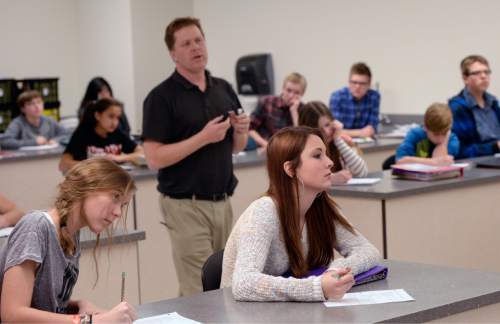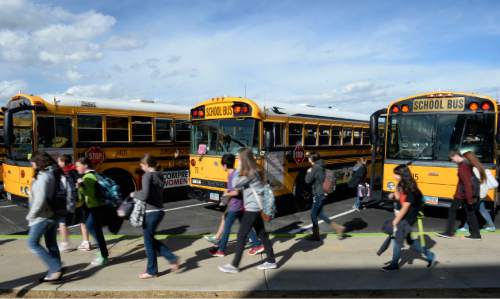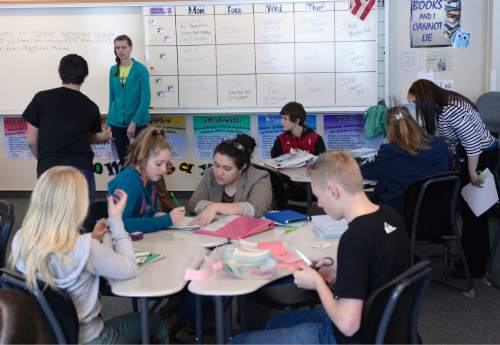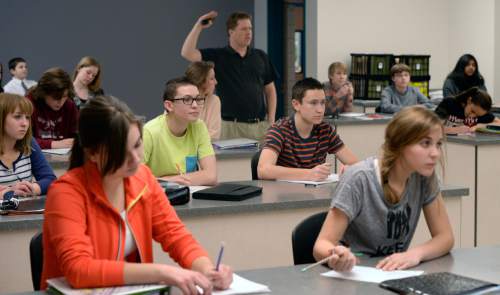This is an archived article that was published on sltrib.com in 2015, and information in the article may be outdated. It is provided only for personal research purposes and may not be reprinted.
When Utah lawmakers increased education spending by roughly $70 per student in 2014, it was one of the largest windfalls of new money to hit the state's public schools since the Great Recession.
But most of that funding never made it through a classroom door.
After paying for increases in retirement and insurance costs, Salt Lake City School District retained just $719,285 of its original $2.2 million appropriation.
That net gain penciled out to roughly $18,000 for each of the district's 40 schools, or less than half the base salary of an additional teacher.
And Salt Lake City School District was one of the lucky ones, with a little extra cash in hand after retiring some bond obligations.
"We were a little bit better off than other districts last year," said spokesman Jason Olsen.
It's a scenario that has repeated itself every year since the recession started, when a plummeting economy, low interest rates and a volatile stock market threw the state retirement system into jeopardy, resulting in annual cost increases that gobbled away at new funding for schools.
This year, retirement system managers are seeing light at the end of the tunnel. Costs have plateaued, meaning schools have fewer budget holes to fill with new money.
"The losses from 2008 have now all been rolled in," said Dan Andersen, Utah Retirement Systems executive director. "Our forecast is that it will hold for the next few years."
It's good news for educators, who are watching lawmakers debate next year's budget without the weight of the Utah Retirement Systems on their backs.
"We're optimistic," Olsen said. "It could be a good year for education, but there's a long time left before that legislative session is over."
That optimism is tempered by caution. Some education leaders worry that less pressure to keep up with retirement accounts means lower incentives for lawmakers to invest new funds.
Without shortfalls to cover, educators fear, lawmakers will turn their attention to earmarks and pet projects, rather than give unrestricted funding to school districts through the weighted pupil unit or WPU, the state's per-pupil funding formula.
"That's the only concern," said Davis School District's finance administrator, Tim Leffel. "Districts will be better off this year because we don't have to take 1 percent off the table automatically because of retirement."
In Davis, last year's per-pupil increase generated $7.7 million for the district. But only $1.4 million, or 18 percent, remained after retirement and insurance costs were paid.
The district received additional state funding because of its comparatively low property values, Leffel said, but also had to manage enrollment growth that required hiring 19 additional teachers to maintain class sizes.
He said without retirement costs chipping away at new money, the district would likely direct part of an increase in per-student spending toward raises for teachers.
"If you look at teacher salaries across the nation, we're toward the bottom," Leffel said. "It is a priority this year to take care of some employee issues, because they haven't really gotten anything since 2008, when the economy dipped."
That priority is shared by Salt Lake City School District, Olsen said. Low salaries have led to excellent educators leaving the district for higher-paying jobs, he said.
"We want to maintain and recruit the highest-quality teachers we can," he said. "Better teachers mean better outcomes for our students."
Gov. Gary Herbert's proposed budget focused almost exclusively on per-student funding, with a requested 6.25 percent jump in the weighted pupil unit.
But the Senate's top budget man, Logan Republican Sen. Lyle Hillyard, said it's too early in the session to speculate about what kind of per-pupil increase schools will get this year.
He also said there is a feeling among his colleagues that investing in specific line items in the budget would bring a better return on investment than simply dumping new funds into the weighted pupil unit.
"We've been doing that for years," Hillyard said, "and we don't get any real change."
Educators, by and large, prefer per-pupil funding, which is distributed equitably to schools and can be used to address local needs as determined by a district's school board. By contrast, funding for line items can be used only in the manner that state lawmakers have determined.
As a hypothetical example, Leffel said lawmakers could earmark all new education dollars for classroom iPads, but school districts still would be on the hook to pay for retirement if the economy plunges again.
"They'd either have to look at raising taxes or cutting programs," he said. "All that money would be locked into technology."
Sharon Gallagher-Fishbaugh, president of the Utah Education Association, said the weighted pupil unit increase in Herbert's budget would help lift Utah's spending rate, which is currently the lowest in the country.
"That would go a long way," she said, "in helping us get at least closer to next-to-last."
But Herbert's proposal includes shifting more than $90 million from transportation funding to education, which Hillyard said would put a strain on spending in the state.
He said lawmakers still are waiting for updated revenue projections, which are expected to be released Feb. 18, and have to prioritize more requests for funding than there are dollars to spend.
But Hillyard noted that education remains the state's top budget priority, and he expects the revenue projections to provide lawmakers with more resources to allocate.
"I personally would predict that we're going to be up."













